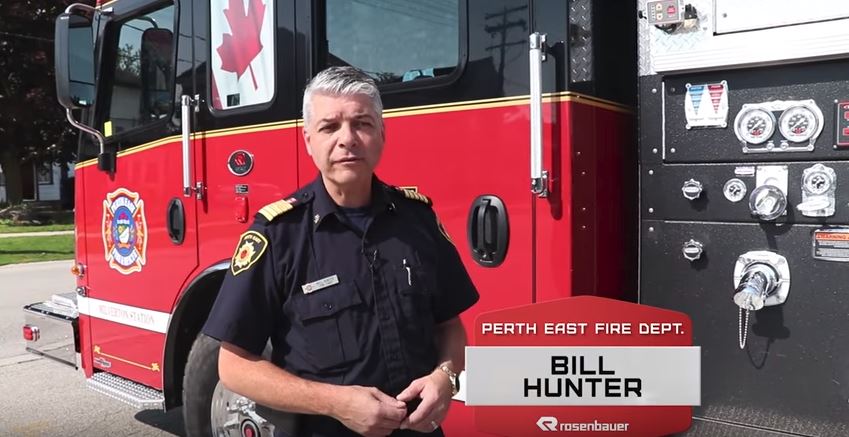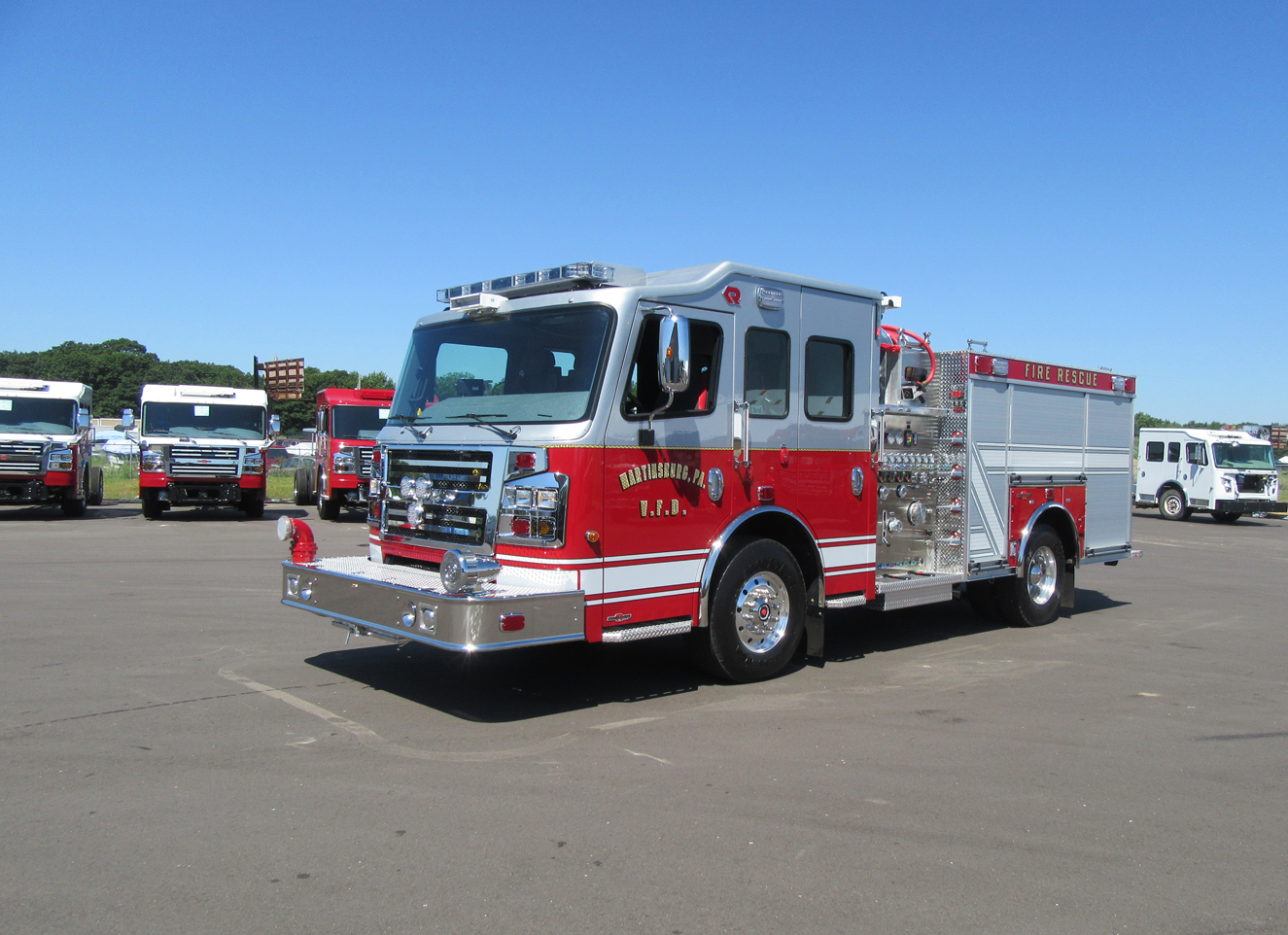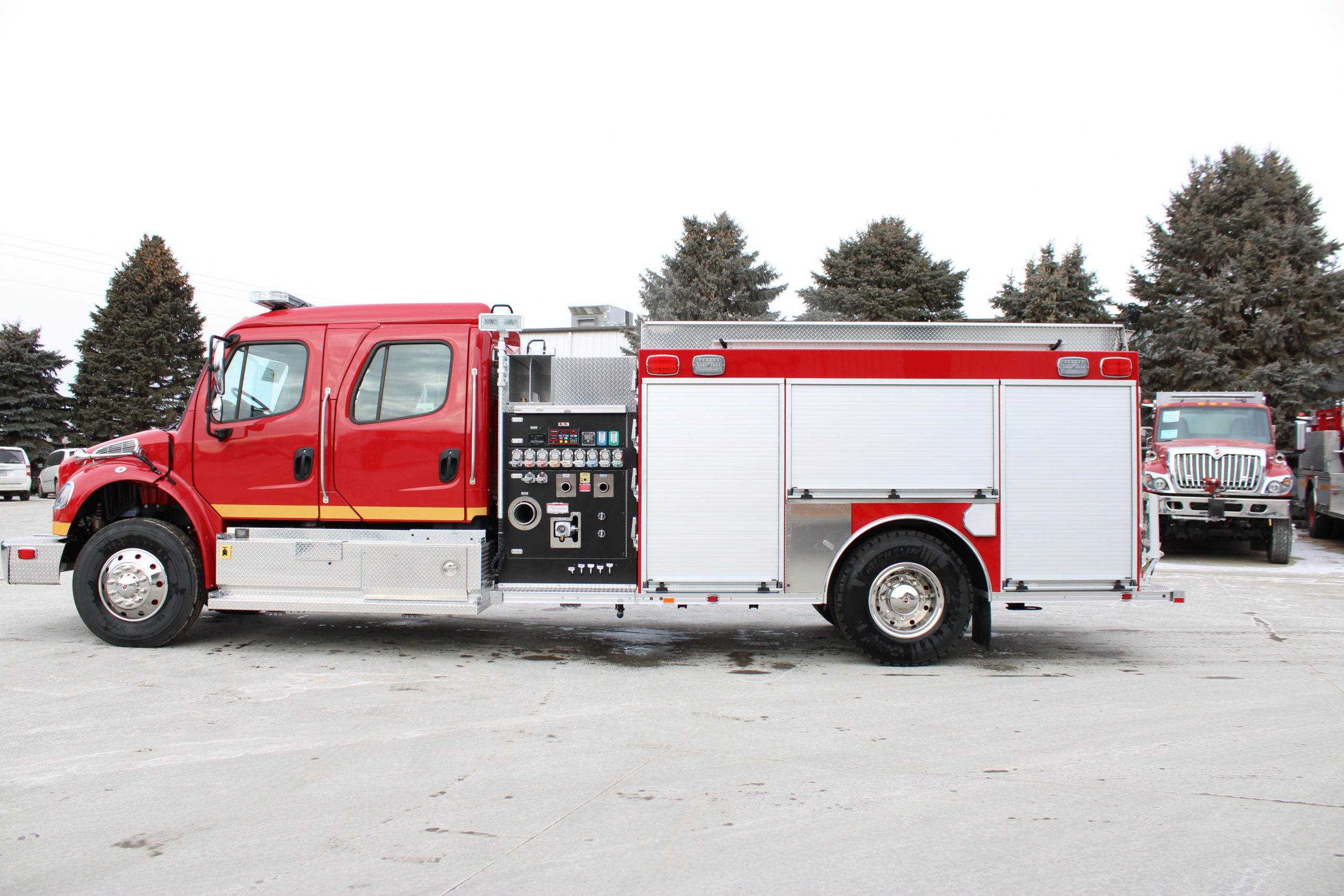Bill Hunter
Perth East, ON
The typical thing, when people have a problem, the first person they call is the fire department because they figure we can solve all their problems, so we try our best. I’m Bill Hunter, the fire chief for the township of Perth East, and the municipality of West Perth. We protect an area of about 550 square miles with 98 staff, three of which are full time. The community definitely presents some unique circumstances for us. The Amish and Mennonite population– there’s different groups. Some have no electricity at all. Some have some, like, chimney fires. They do a lot of cooking on wood stoves, heat their homes with wood stoves, might use kerosene lanterns to illuminate their home. So there’s different things like that that– it increases the risk of fire in their homes.
One of the features that we had designed into the truck was a compartment in the front bumper for all of our chimney fire equipment. In the old days, the firefighters would climb the ladder, usually with a bucket with a chain and some tools in it to try and put out the fire in the chimney, and Rosenbauer was able to design a box that carries all of that equipment. We hook it onto the end of the ladder, and it actually takes it up to the chimney, and then the firefighters can just climb the ladder safely. All their equipment’s in the box, and then they can work on putting out the chimney fire.
This station had an engine and an old snorkel truck. We looked at replacing both trucks separately, and then as far as trying to be fiscally responsible and working within our budget, we were able to design a truck that would do the duties of both trucks and provide a much safer work environment for the firefighters. It’s worked out tremendously. Just going through the numbers, we figure that we have probably saved the township about $350,000 by delaying the replacement of another truck down the road, by relocating the assets that we have. And it’s all due to being able to combine two trucks in the one. It can act as a front line engine. It’s got a 78 foot ladder. It can do all of our elevated work, transport six firefighters and their equipment very safely to and from scenes. It’s doing everything that it’s been designed to do.
I find that this community is rural in nature, but you get to know your neighbors. There is actually 13 one-room school houses that this station protects. So we make sure that we get around and visit every single one of them, and the community festivals, participating with local organizations. This afternoon, the guys are working on a blood donor clinic here in town. So they’re going to take the truck over. They’ll set it up. We got a big Canadian flag to fly off the end of the stick, and then my public educator is going to have a table set up inside, and then we’re going to try and hopefully encourage more people to come and donate blood.
This is our Rosenbauer Viper, a 78 foot aerial that operates out of the Milverton station, and I’m going to take you through some of the features that we’ve worked into this truck. Start out at the pump panel. Basically, one of the things during specifications was that we would somewhat duplicate the pump panel set up from our other engines, just to improve the familiarity from apparatus to apparatus for our firefighters. So we were able to work with Rosenbauer to lay this out as closely as possible to our other existing engines.
Lots of good features on this. It’s got– all the discharges are the push pull discharge, which gives the pump operator really fine control over the flow and pressure that he’s applying to the fire hoses. Have an intercom system– a three point intercom system. The pump operator can wirelessly talk to the operator on the turntable, who can also talk to the firefighters that are working at the tip of the 78 foot ladder. And at the tip of the ladder, it’s all hands free.
First compartment– so the pump operator has extra nozzles and different tools that he’s going to need, stretching additional lines off the truck. We also keep our accountability board in this compartment. One of the nice features of this truck– we have receiver units for our winch located on all four sides, but our accountability board is also designed that we can place it in those receivers so that the accountability board is always in the right spot, depending on the scene. And in the next compartment, this is basically all hose appliances for the pump operator. Some different valving, different nozzles. The top shelf is an out and down compartment, so it brings the tools down to a safe level for the pump operator to reach up and take them out. SCBA bottle storage. The truck is designed to carry the NFPA requirement for spare SCBA bottles.
So center compartment, we keep forcible entry tools and our RIT pack in here on swing out tool boards. We can bring the tool boards out for the equipment that’s behind, and we keep RIT pack, set of irons. Everything’s available for the rapid intervention team, so they can just grab whatever tools they need and get prepared. Last compartment on this side– carry spare SCBA for the driver. Five packs inside the cab and the sixth pack is kept out here. Harneses for our firefighters. All of our firefighters, before they climb the ladder, have to put a harness on, so that they can be tied off at the end of the tip. And kind of the neat thing that the guys made up themselves are these little chemical grenades, basically, for chimney fires. They can deploy these down a chimney and put out a chimney fire.
So back here we have one compartment that we keep our ladders– hard suction. Two different sizes of hard suction. We have an aerial water way valve here. So at a large fire where the ladder is up and flowing water, we can supply it directly to the aerial waterway from another one of our engines. The controls on the rear of the truck have another control screen for the ladder. Also have all of our outrigger controls and we also have another remote water level gauge, so that no matter where you are around the truck, you know how much water is available.
Moving to this side, another set of controls in behind a panel. This operates the easy loader and also the right outrigger. And our easy loader– this is where all of our 100 millimeter or four inch supply hose is kept. Very easy to deploy it, and then as far as stowing it, we can lower the easy lowerer to the ground. So I bring you down the officer side of the apparatus, and the first compartment at the rear– we keep our chainsaws, quick cut saws. There’s actually one saw that’s out for repair right now.
This compartment, we’ve got our positive pressure fan on a pull out tray. Last compartment on this side, another pull out tray. This one actually has our portable winch. Another small out and down here with some electric tools available for the firefighters. The officer side pump panel. This is our pressurized intake side. So when we hook up to fire hydrants, we’ve got that availability here. We’ve got a large diameter discharge. If this truck is used as an engine, it can actually pump through our 100 millimeter hose up to another one of our apparatus.
Truck’s got a 28 inch extended front bumper, and we’ve designed in a lot of features into this bumper to go along with the whole theme of trying to keep our firefighters on the ground when they’re working. The first compartment in the bumper– this is where we keep our chimney fire equipment. It’s a box that Rosenbauer was able to design for us– store all of our equipment in this. It eliminates our firefighters having to carry that chain up and down the ladder. Also in the front, one of the receivers for the winch, and also our accountability board, and then a hydro connection. And then the biggest feature for the front bumper, that the firefighters certainly like and keeps everyone safe, is we’ve got two 200 foot lengths of 1 inch and 3/4. That’s 45 millimeter hose here in Canada.
For our firefighters, they can access this from the ground, do a quick fire attack, and when they put it away, everything’s done right here. There’s lighting underneath, so at night, they can see what they’re doing and everything’s nice and safe. Guys aren’t having to climb up on top of the trucks. So that’s our Rosenbauer 78 foot Viper aerial. We’re super impressed with this truck. Nothing but good things to say about it. Very, very easy truck to be very proud of. Great workmanship put into it, and I’m sure that you’ll get the same level of service from Rosenbauer as we did.



